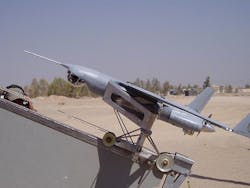Insitu to provide 65 ScanEagle UAVs and ScanEagle training facility for Afghanistan
LAKEHURST, N.J., 1 Dec. 2015. U.S. Navy unmanned vehicle experts are establishing an in-theater training facility in Afghanistan to help Afghan military forces lean to use Insitu ScanEagle small unmanned aerial vehicles (UAVs) under terms of a $70.9 million contract announced last week.
Officials of the Naval Air Warfare Center Aircraft Division in Lakehurst, N.J., are asking Insitu Inc. in Bingen, Wash., to provide the Afghan military with 65 ScanEagle UAVs, spare parts, field support, and training. Insitu is a subsidiary of the Boeing Co.
The contract is for eight ScanEagle unmanned aircraft systems for the government of Afghanistan under the Foreign Military Sales program. These systems consist of 65 ScanEagle Air Vehicles, spares, support equipment, field service support, an in theater ScanEagle training facility, and training.
The ScanEagle UAV is 5.1 feet long with a 5.6-foot wingspan. It weighs as much as 48.5 pounds and can carry a 7.5-pound sensor payload. The UAV can fly for more than 24 hours at altitudes as high as 19.500 feet, and at speeds to 80 knots. The unmanned aircraft can fly on gasoline or heavy fuels.
Related: Special Operations Command looks to Insitu and ScanEagle UAV for 24/7 ISR contract services
The mission of ScanEagle is to provide persistent surveillance and reconnaissance imagery on land or at sea at lower costs than other surveillance methods for military and agriculture missions.
ScanEagle can carry a sensor payload consisting of visible-light camera, medium-wave infrared imager, or both integrated in one turret. The UAV ans has an analog digitally encrypted video data link, as well as encrypted or unencrypted command-and-control data link.
The UAV can be launched autonomously and uses a no-nets recovery system that recovers with its wing tip on a rope that hangs from a boom.
On this contract Insitu will do the work in Bingen, Wash., and at undisclosed sites throughout Afghanistan, and should be finished by June 2018. For more information contact Insitu online at www.insitu.com or the Naval Air Warfare Center Aircraft Division-Lakehurst at www.navair.navy.mil.

